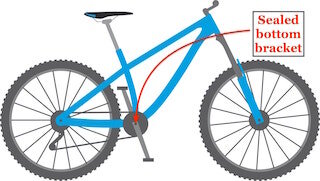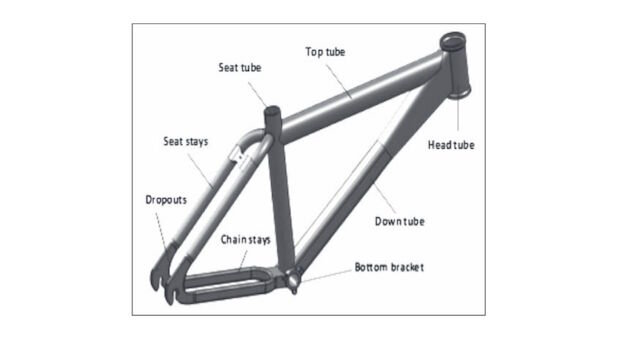What is the bottom bracket on an MTB?
The bottom bracket bearing assembly, commonly referred to as ‘bottom bracket’ connects the crankset to the bicycle and allows the crankset to rotate freely and is located at the base of the stem that goes from the center of the pedal to the top of the saddle.
The bottom bracket can include a spindle attached to the crankset, and bearings that allow the spindle and pedal cranks to rotate.
Bottom Bracket (upper right) - Image Source: Hull and Bolourchi
The pedals and cranks are attached to the bike with the bottom bracket rotating freely between the connected pedal cranks. This allows the pedals to crank the rear wheel into motion when the cyclist pedals the bike.
what is the Bottom bracket in plain English?
The bottom bracket is basically the transmission of your MTB. The rider (you) is the motor, with the bottom bracket (BB) acting as the transmission.
“The bottom bracket is the ‘spinny’ thing where the pedals come together ”
High-end mountain bikes & racing bikes have top-quality bottom brackets since this part is directly responsible for the transfer of power between the rider and the bike. The BB is subjected to extreme pressure and torque, especially when your standing on the bike pedaling up steep terrain.
Wobbly bottom bracket
Most people are familiar with the bottom bracket wobble, which is when your pedaling and the crankset mechanism is going from side-t0-side. Years ago, when the BB was less advanced and was ready to be replaced, you might remember a bunch of tiny ball-bearings falling out and scattering across the road. Today, the BB is a single sealed cartridge with no ball-bearings running around to signal repair, but the unmistakable wobble is still there.
Simple Bottom Bracket wobble Test
Put the chain on the smallest chainring and spin the pedal crank, if there’s a side-to-side wobble, or if it’s spinning roughly then it’s time to get a new bottom bracket.
The bottom bracket bearing assembly system
The bottom bracket is the bearing system found between the pedal cranks of your MTB:
The bottom bracket sits in the bracket shell (base of the bike at bottom of the seat tube)
The bearings are held in place by ‘cups’ or by an adaptor
The spindle of the crankset passes through the bottom bracket bearing and is connected by both pedal-crank-arms
types of bottom brackets
There are over 20 different types of bottom brackets, with more being developed every year. Some BB’s are bike or brand specific, while others are more universal. However, as bike technology has improved, so have bottom brackets.
The importance of this little part is highly significant since it’s responsible for the pedals spinning, which propel the bike.
bottom bracket shell
The Bottom Bracket Shell is where the bearings go. (Image Source: Rontescu et al.)
BB: Lots of Types But Few General Categories
Even though there are dozens of different types, there are only a few general categories of bottom brackets:
Threaded/traditional - Most common
Press-fit - No internal threading
Spanish press-fit & mid-press-fit - Both are BMX standard
1) Threaded Bottom Bracket
2) Press-fit Bottom Bracket
Bottom bracket performance & weight
For many MTB components and bike parts lighter usually is better. However, when it comes to the BB and other drive-train parts, lighter often times just means more fails, repairs, and frustration out on the trail.
Quality top-end bottom brackets should be:
High strength - Durable
Low friction - Increased pedal efficiency
In ‘standard bikes much power loss is due to inefficiencies in the bottom bracket, which is why bottom brackets are continually evolving, more so than many other components. The bicycle drivetrain components have a significant role in the overall efficiency of your MTB, and it all starts with your MTB’s transmission.
Jesse is the Director of Pedal Chile and lives in La Patagonia. Jesse has a Master of Science in Health and Human Performance and a Bachelor of Science in Kinesiology. Hobbies: Mountain biking, bicycle commuting, reading, snowboarding, researching, and sampling yummy craft beers.
References:
Covill, D., Allard, P., Drouet, J.-M. and Emerson, N. (2016). An Assessment of Bicycle Frame Behaviour under Various Load Conditions Using Numerical Simulations. Procedia Engineering, 147, pp.665–670.
Downs, T. (2010). The Bicycling guide to complete bicycle maintenance & repair for road & mountain bikes. Emmaus, Pa.: Rodale.
Lin, Chien-Cheng, et al. “Structural Analysis and Optimization of Bicycle Frame Designs.” Advances in Mechanical Engineering, vol. 9, no. 12, Dec. 2017, p. 168781401773951, 10.1177/1687814017739513.
Hull, M L, and F Bolourchi. “Contributions of Rider-Induced Loads to Bicycle Frame Stress.” The Journal of Strain Analysis for Engineering Design, vol. 23, no. 3, 1 July 1988, pp. 105–114, 10.1243/03093247v233105.
Rontescu, Corneliu & Cicic, Dumitru & Amza, Catalin Gheorghe & Chivu, O.R. & Dobrota, Dan. (2015). Choosing the optimum material for making a bicycle frame. Metalurgija -Sisak then Zagreb-. 54. 679-682.
















